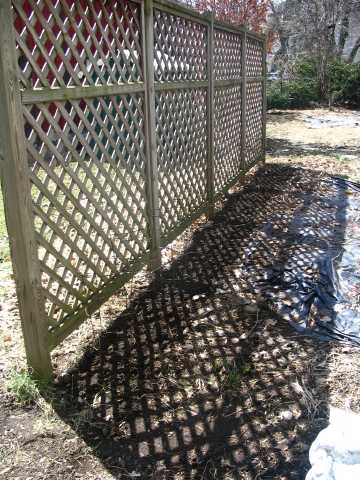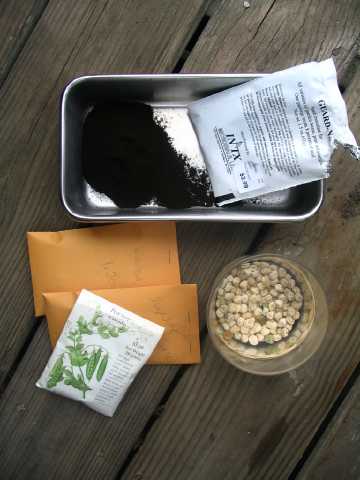We planted the peas today which worked out to a nice 20 minute task. About a week ago, we’d scraped away the mulch from the soil where we intended to plant. The sun was able to warm the soil up to a pea-friendly 50 degrees F (10 degrees C) We were able to check the soil temperature with this fancy soil thermometer we got years ago with our CompostTumbler. (I forgot we had a soil thermometer until Jan uncovered it next to the seed storage area.) A soil thermometer is especially fun for checking compost because a properly assembled compost pile of the proper size will actually start to “cook,” that is, it will heat up inside. The heat is high enough to sterilize some weed seeds. The thermometer is handy for checking when this hot phase has subsided. But I’ve gone a long way from the peas.
Today was the first really beautiful day outside which meant we also wanted to do things other than spend it all in the garden. We were out in short sleeves enjoying the sunshine.
The pea garden is about a foot wide and will run roughly 16, maybe 20 feet long. (Jan and I have a disagreement about its length at present. I shall resolve it tomorrow with a tape measure and if I am correct, I’ll make sure everyone knows.) The bed is located on the north side of a latticed screen divider and this dividing screen has four sections. Conveniently enough, we have four different kinds of peas: Progress No. 9, Cascadia, SugarSnap (registered trademark) and Wanda.
We prepared the bed by gently disturbing the soil down to a depth of about 4 inches with a long handles garden claw. We used the handle end of the claw to poke a pattern of holes. The pattern resembles the five dots on a die: two, one, two, one… This arrangement allows the most number of plants to grown in the area of the bed. We also scavenged up 16 of the shorter sized “tomato” cages so the peas can have something to grow on. I usually put the cages on the beds when I plant rather than waiting until later if for no other reason that it visually reminds me what areas are already done. You don’t need to use tomato cages though; you can use “pea bramble,” at least that the phrase I’ve heard them called. Peas vines will grab around anything that’s relatively thin, including wind-fallen tree branches. The spring rains usually bring down a good number of these so they provide a nice rustic looking alternative.
We prepared the seeds by briefly soaking them in water. Some years we’ve soaked the seeds over night (too long, the seeds fell apart) The most important reason for wetting the seed is so that the rhizobial bacteria will stick to the seed so we opted for a particularly short soak this year. A quick tumble in a container filled with the innoculant made the seeds look almost like chocolate covered peanuts… ALMOST.
Other notes: We planted them too thickly perhaps. We’ll see. We remembered to save half of the SugarSnap (registered trademark) and half of the Wanda for a late season crop but we probably should have remembered to save more!
Now, I hope I like fresh peas as much as I think I do!





